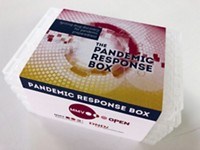Advertisement
Grab your lab coat. Let's get started
Welcome!
Welcome!
Create an account below to get 6 C&EN articles per month, receive newsletters and more - all free.
It seems this is your first time logging in online. Please enter the following information to continue.
As an ACS member you automatically get access to this site. All we need is few more details to create your reading experience.
Not you? Sign in with a different account.
Not you? Sign in with a different account.
ERROR 1
ERROR 1
ERROR 2
ERROR 2
ERROR 2
ERROR 2
ERROR 2
Password and Confirm password must match.
If you have an ACS member number, please enter it here so we can link this account to your membership. (optional)
ERROR 2
ACS values your privacy. By submitting your information, you are gaining access to C&EN and subscribing to our weekly newsletter. We use the information you provide to make your reading experience better, and we will never sell your data to third party members.
Business
Probing Questions
A public-private partnership aims to find and share new compounds for epigenetics research
by Lisa M. Jarvis
April 16, 2012
| A version of this story appeared in
Volume 90, Issue 16
Epigenetics, the study of how gene expression is controlled without changes to underlying DNA, holds great promise as a new avenue for drug discovery. But the field has been stalled by the lack of good tool compounds—highly selective chemical probes that help researchers determine the biological function of a given target.
The Structural Genomics Consortium, a public-private partnership set up in 2004 and dedicated to open-access drug discovery research, is trying to tackle the probe problem and, in the process, ignite research around epigenetics. SGC has assembled a team of researchers from industry and academia to find tool compounds and make them publicly available—with no strings attached.
Tool compounds don’t have the same qualities as a drug candidate; they don’t have to be safe to give people or be exceptionally bioavailable. But they do need to be robust enough to inhibit or otherwise alter the activity of epigenetic proteins so researchers can start to understand their function.
“You don’t necessarily solve biology problems using only biology tools—there’s this whole world of chemicals out there,” explains Michael D. Varney, senior vice president of small-molecule drug discovery at Genentech. “You have to have a molecule that at least has a potency and selectivity profile that really can allow you to interpret the results in your experiments and draw conclusions from them. That isn’t a trivial undertaking.”
SGC’s efforts are rooted in several years of discussions among the nonprofit’s director, University of Toronto protein biochemist Aled M. Edwards, and other scientists about the impact of chemical probes. Edwards and colleagues’ conversations eventually led them to conduct an analysis of journal articles, released in 2009, to understand the impact that a publicly available chemical probe has on biomedical research (Nat. Chem. Biol., DOI: 10.1038/nchembio0709-436).
They discovered that when a chemical probe was made available without restrictions, a cluster of biomedical research around its target emerged, Edwards says. Moreover, SGC’s analysis revealed that the onslaught of research doesn’t correlate to the genetic importance of the target; rather, the research is spurred simply by the availability of the probe. “That was a rather striking finding,” Edwards says. “We felt these are incredibly powerful ways to open up new areas of science.”
At the time, epigenetics researchers were in desperate need of tool compounds to explore the fundamental biology of proteins. Plenty of clues implicate epigenetic enzymes in disease, but scientists cannot thoroughly interrogate their function without chemical probes. “There’s enough smoke to know there’s a fire somewhere,” Edwards says, “but we don’t know what the biological role or therapeutic area is.”
SGC’s academic scientists had solved many protein structures and developed critical assays relevant to epigenetics, but they recognized that the best tool compounds have historically come from drug companies. The most efficient route to finding new probes, they decided, would be to get medicinal chemists from industry on board.
The problem was that industry-discovered molecules are often released with restrictions or years after they’ve already been thoroughly investigated. Companies hold back out of fear that a tool compound might one day translate into a drug candidate. Making it freely available could sacrifice precious intellectual property (IP).
One scientist involved in the journal articles analysis was Timothy M. Willson, a medicinal chemist at GlaxoSmithKline. Willson made the case to GSK managers that the benefits of participating in a partnership with SGC outweighed the risks. By 2009 his bosses were sufficiently convinced, and SGC’s chemical probes project was launched. Edwards gives credit to GSK for buying into open access. “They took a big risk, because nobody in academia thought this would happen,” Edwards says. “GSK was a real pioneer.”
Today the project has several academic collaborators and a number of pharma firms, including GSK, Abbott Laboratories, Eli Lilly & Co., Pfizer, Novartis, and Takeda Pharmaceuticals. Its resources are spread across targets to avoid duplication of efforts. Companies work individually toward finding tool compounds, but anything that is discovered goes immediately into the public domain.
“The thing that makes us effective is we don’t generate any IP,” says Stephen V. Frye, director of the Center for Integrative Chemical Biology & Drug Discovery at the University of North Carolina, Chapel Hill, and a participant in SGC. “That approach just lowers the barrier so much to collaboration, because I will send our epigenetic compound to anybody.”
SGC estimates each probe can cost $2 million to develop. Drug companies commit $5 million apiece to be part of the consortium and dedicate in-house medicinal chemistry efforts. SGC also has secured government grants specifically to help fund the chemical probe project.
To date, Edwards says, “six or seven nice molecules,” including UNC0638, developed by Frye, and JQ1, developed by SGC and a team at Boston’s Dana-Farber Cancer Institute, have been made public, and a pipeline of projects is in the works. Although the utility of the tools remains to be seen, Edwards is enthusiastic about the progress. If even one epigenetic target is proven to be interesting because it can be validated by an SGC-generated tool compound, “it’ll cause a tsunami of people to work on it,” he says.








Join the conversation
Contact the reporter
Submit a Letter to the Editor for publication
Engage with us on Twitter